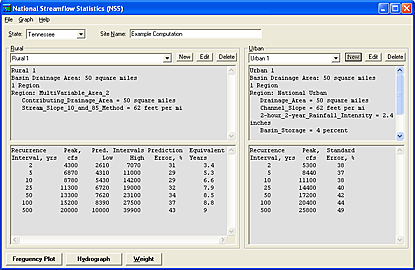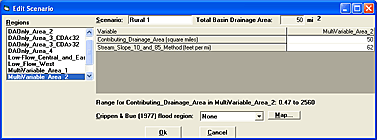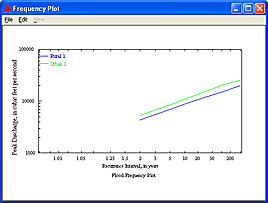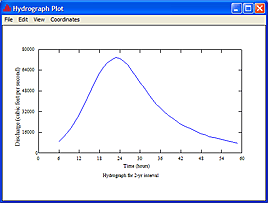Office of Surface Water
USGS hydrologic analysis software is available for electronic retrieval through the World Wide Web (WWW) at http://water.usgs.gov/software/. The WWW page from which the NSS software and user documentation can be retrieved is http://water.usgs.gov/software/nss.html. NSS requires a computer running Windows1 98/NT Version 4.0 or higher with service pack 5 or higher. For optimal performance, a processor running at 400 megahertz or faster with at least 64 megabytes of memory is recommended. A video graphics array or a higher quality color monitor is also recommended. |
The National Streamflow Statistics (NSS) Program provides an easily accessible graphical user interface to estimate high and low streamflow statistics for ungaged sites across the United States. Streamflow statistics, such as the mean flow, the 100-year flood, and the 7-day, 10-year low flow (7Q10), are needed and used for a variety of design, planning, and management purposes. These streamflow statistics can be easily computed using the NSS Program. Regression equations developed from data for gaged sites found within a statistically significant hydrologic region are often used to estimate streamflow statistics for ungaged sites in that region.The equations are developed by statistically relating computed streamflow statistics to measured physical and climatic characteristics of the watersheds for ungaged sites. The equations typically take a form similar to:
Q100 = 0.471A0.715 * E0.827
where
Q100 is the estimated flood discharge for a flood with a 100-yr recurrence interval,
A is drainage area, in square miles, and
E is mean basin elevation, in feet.
The characteristics and constants in the equations vary regionally to reflect hydrologic conditions. Users enter measured watershed and(or) climatic characteristics into the equations to obtain estimates of streamflow statistics for an ungaged site.
The U.S. Geological Survey (USGS) has created a Microsoft Windows1 computer program named the National Streamflow Statistics (NSS) Program, version 4, to make it easy for users to obtain estimates of streamflow statistics for ungaged sites throughout the Nation (Ries, 2006). The NSS Program, version 4, is a replacement for the National Flood Frequency (NFF) Program, version 3 (Ries and Crouse, 2002). The name change from NFF to NSS reflects the primary enhancement to the program, which now provides estimates for many other types of streamflow statistics and not just estimates of flood-frequency statistics, such as the 100-year flood.
Regression equations for estimating flood-frequency statistics are available in the NSS Program for every State, the Commonwealth of Puerto Rico, and the island of Tutuilla, American Samoa. Regression equations for estimating other types of streamflow statistics, such as those derived from low-flow duration and(or) frequency regression equations, are currently (2007) available in the NSS Program for less than half of the Nation. The regression equations contained in the NSS program were compiled from USGS reports that generally were prepared in cooperation with individual State Departments of Transportation, and(or) other government agencies, and were published either by the USGS or by cooperating organizations.
The NSS Program has the following four components: a user interface, an equation calculation routine, a database, and a help feature. The user interface allows users to control the operation of the software and presents results. The equation calculation routine computes streamflow statistics using basin and climatic characteristics entered by the user and provides tabling and graphing capabilities. The database contains all the information needed, such as the regression coefficients and standard errors, to solve more than 2,000 regression equations. The help facility contains the NSS Program user's manual (Ries, 2007), a link to the NSS Program Web page, and version information. The NSS program is written in the Visual Basic programming language.
Version 4 of NSS can be used to:
NSS can be downloaded from the Internet at the Web address listed at the end of this fact sheet. Users will need to download at least two files, as follows: (1) NSSv4.exe, which contains the NSS Program Setup Wizard and the NSS computer program (about 6 Mb), and (2) NSSv4_MM-DD-YYYY.mdb, which is the database (about 25 Mb), where MM is the month, DD is the day, and YYYY is the year of the most recent release. A file to help the user install and operate the software (NSSreadme.txt) can also be downloaded from this site; the instructions in this file should be read before attempting to install the program. Each file should be downloaded to the local hard drive by double-clicking on the file names or icons for the files shown in the Web browser window. Next, go to the location of the file “NSSv4.exe” on the local hard drive using Windows Explorer or My Computer. Double-click on the file name “NSSv4.exe” to start the NSS Program Setup Wizard. The Setup Wizard will prompt for a directory name in which the NSS Program will be installed (the default is, C:\Program Files\NSS\); allow selection of the Start Menu folder in which to place the program’s shortcut (the default is C:\Programs\USGS); and ask whether or not to create a desktop icon for the program. After all of the selections are completed, click on the Install button to complete the installation. The database file must then be copied to the NSS Program directory when the installation is complete.
Region-of-influence analysis methods are currently (2007) available for estimating peak discharges for six States. Additional files that contain data needed for these analyses must be downloaded from the NSS Program Web site and placed in the directory where the NSS Program is stored.
 Figure 2. Main NSS Program window. |
Two large frames—one for rural estimates (on the left) and the other for urban estimates—fill the center of the main window. The box at the top left of each frame shows the name of the current scenario (a set of estimates for a site). To the right of the box is a set of three buttons (New, Edit, and Delete), allowing users to (1) create a new scenario, (2) edit the current scenario, and (3) delete the current scenario, respectively. Below the buttons are two text boxes. The top box shows input parameters used to evaluate the regression equations for the scenario. The bottom box shows the output, including the recurrence intervals, the estimated peak flows, the standard errors of estimate or prediction, and the equivalent years of record for the estimates. The standard errors and the equivalent years of record provide indications of the reliability of the estimates.
Clicking on either of the New buttons opens the Edit Scenario window (fig. 3), which allows users to select the hydrologic region of interest and enter the basin and climatic characteristics needed to evaluate the equations for that region. The scenario name can be specified by typing it into the box at the top of the window, or the program will automatically name the scenarios based on the type of scenario (rural or urban) and the number of scenarios that have previously been run. A list of the hydrologic regions available within the State is presented on the left side of the window. Selection of a region will cause a list of the basin and climatic characteristic that are needed to solve the regression equations for the region to appear in a grid within the window. Users should enter characteristic values in the boxes next to the characteristic names. Placing the cursor over one of these boxes or clicking in a box causes the minimum and maximum values of the basin and climatic characteristics that were used to develop the equations to appear in a pop-up text box and in a text line below the list of basin and climatic characteristics. Values outside the ranges shown can be entered, but the resulting peak-flow estimates will be extrapolations with unknown errors.
 Figure 3. Edit Scenario window. |
Sauer and others (1983) developed regression equations for estimating flood frequencies for urban ungaged sites throughout the United States that are included in the NSS Program. Additional local urban equations are available in the NSS Program for several States and municipalities. The national urban regression equations and most local urban regression equations use the rural estimates as an explanatory variable in the equations; therefore, usually generation of rural estimates is required before urban estimates can be obtained. The NSS Program generates a warning when urban estimates are requested for a site, and the rural estimates for the site have not yet been determined.
Three buttons at the bottom of the main window (fig. 2) access the Frequency Plot, Hydrograph, and Weight options. Clicking on any of these buttons after a rural scenario is created causes another dialogue window to open. The Frequency Plot window allows selection of the plotting scenario in a secondary window. Once a selection is made, clicking the Plot button causes the selected plotting scenario to be generated in the Frequency Plot window, as shown in figure 4. Pull-down menus in the plot window allow printing and saving the plots, modifying of axes, titles, line styles and legends, listing of the data used to create the plot, and closing of the plot window.
The Hydrograph window allows selection of the scenario and the recurrence interval to be plotted, as well as a lag time. If the scenario is based on the national urban equations (Sauer and others, 1983), the lag time can be estimated by specifying the basin length in miles. Other methods for estimating lag times are provided in an appendix at the end of the user's manual included with the program, as described later. Once a selection is made, clicking the Plot button causes a window to open with the hydrograph plot (fig. 5). The pull-down menus in the plot window provide for printing and saving the plot, modifying the axes, titles, line styles, and legend of the plot, as well as listing the data used to create the plot, and closing the plot window.
 Figure 4. Frequency Plot window. |
 Figure 5. Hydrograph Plot window. |
The Weight window can be selected to compute weighted estimates for both gaging stations and ungaged sites. A rural scenario of regression estimates must first be obtained for a gaging station before weighted estimates can be obtained for the station. When the Weight window is opened, a button at the top of the window is initally set to calculate weighted estimates for a gaging station. Entering the years of actual record for the gaging station and the peak-flow estimates determined from observed data will cause weighted estimates to be calculated for the gaging station based on the length of years of observed data and the equivalent years of record for the estimates. Clicking on the Apply button saves the weighted estimates as a weighted scenario and makes them appear in the output box of the rural frame in the main NSS Program window.
The weighting feature for ungaged sites requires that the drainage area for the ungaged site must be within 0.5 and 1.5 times the drainage area for an upstream or downstream gaging station. Before the weighted estimates for the ungaged site can be obtained, first use the NSS Program to create a scenario of weighted estimates for the gaging station, and then create a rural scenario for the ungaged site. When the Weight window is opened, click on the button at the top right of the window that allows weighting for an ungaged site using weighted-gaged values. Select the rural weighted scenario for the gaging station from the pull-down list that will appear in the window, then click on Apply to compute the weighted estimates for the ungaged site and make them appear in the output box of the rural frame in the main NSS Program window. These weighted estimates combine the weighted estimates for the gaging station with the regression equation estimates for the ungaged site on the basis of drainage area.
The user's manual can be accessed through the Help menu at the top of the NSS Program main window. It provides complete documentation of the technical methods used to develop the functionality included in the software and detailed directions for using it.
The NSS Program Web site provides links to reports that document the software, reports, and summaries that document the equations included in the software, and the information necessary to solve the equations. The NSS Program Web site and links are updated as new equations become available. It is recommended that users check these sites periodically to determine whether changes in the software have been made or new equations have been developed for areas of interest that will require obtaining an updated version of the database and new documentation.
By D. Phil Turnipseed and Kernell G. Ries IIICrippen, J.R., and Bue, C.D., 1977, Maximum floodflows in the conterminous United States: U.S. Geological Survey Water-Supply Paper 1887, 52 p.
Jennings, M.E., Thomas, W.O., Jr., and Riggs, H.C., comps., 1994, Nationwide summary of U.S. Geological Survey regional regression equations for estimating magnitude and frequency of floods for ungaged sites, 1993: U.S. Geological Survey Water-Resources Investigations Report 94-4002, 196 p. + 1 CD.
Ries, K.G., III, in press, 2007, The National Streamflow Statistics Program: A computer program for estimating streamflow statistics for ungaged sites: U.S. Geological Survey Techniques and Methods Report TM Book 5, Chapter A6, 45 p.
Ries, K.G., III, and Crouse, M.Y., comps., 2002, The National Flood Frequency Program, Version 3: A computer program for estimating magnitude and frequency of floods for ungaged sites, 2002: U.S. Geological Survey Water-Resources Investigations Report 02-4168, 53 p.
Sauer, V.B., Thomas, W.O., Jr., Stricker, V.A., and Wilson, K.V., 1983, Flood characteristics of urban watersheds in the United States: U.S. Geological Survey Water-Supply Paper 2207, 63 p.
Download: PDF of FS2007-3010 (429KB).
| AccessibilityFOIAPrivacyPolicies and Notices | |
 |
|